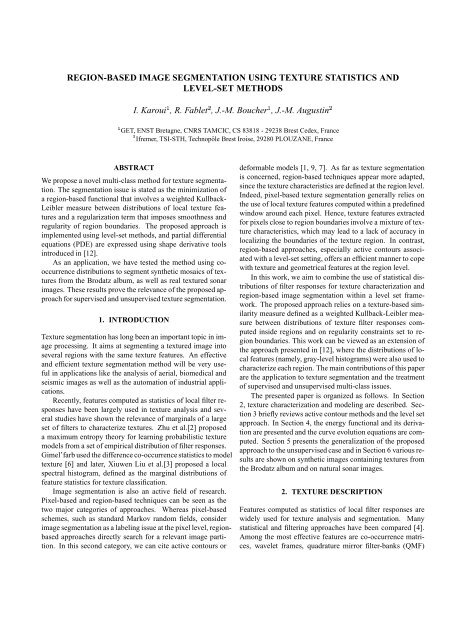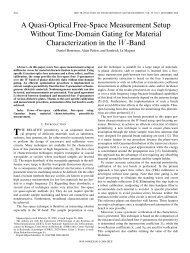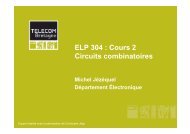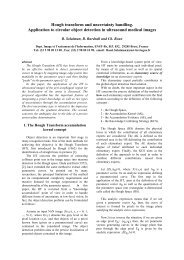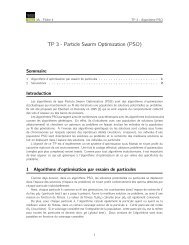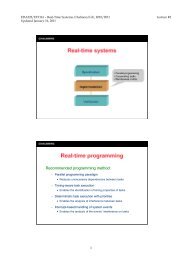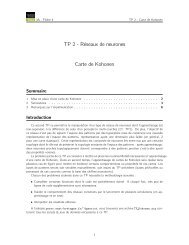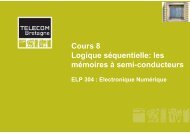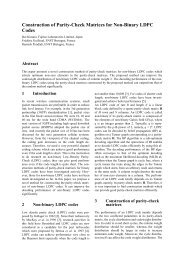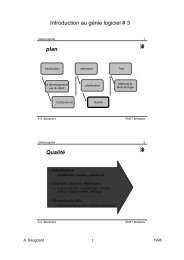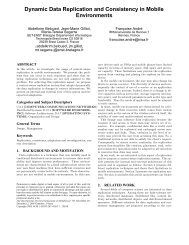REGION-BASED IMAGE SEGMENTATION USING TEXTURE ...
REGION-BASED IMAGE SEGMENTATION USING TEXTURE ...
REGION-BASED IMAGE SEGMENTATION USING TEXTURE ...
You also want an ePaper? Increase the reach of your titles
YUMPU automatically turns print PDFs into web optimized ePapers that Google loves.
¢<strong>REGION</strong>-<strong>BASED</strong> <strong>IMAGE</strong> <strong>SEGMENTATION</strong> <strong>USING</strong> <strong>TEXTURE</strong> STATISTICS ANDLEVEL-SET METHODSI. Karoui , R. Fablet ¡ , J.-M. Boucher , J.-M. Augustin ¡GET, ENST Bretagne, CNRS TAMCIC, CS 83818 - 29238 Brest Cedex, France£Ifremer, TSI-STH, Technopôle Brest Iroise, 29280 PLOUZANE, FranceABSTRACTWe propose a novel multi-class method for texture segmentation.The segmentation issue is stated as the minimization ofa region-based functional that involves a weighted Kullback-Leibler measure between distributions of local texture featuresand a regularization term that imposes smoothness andregularity of region boundaries. The proposed approach isimplemented using level-set methods, and partial differentialequations (PDE) are expressed using shape derivative toolsintroduced in [12].As an application, we have tested the method using cooccurrencedistributions to segment synthetic mosaics of texturesfrom the Brodatz album, as well as real textured sonarimages. These results prove the relevance of the proposed approachfor supervised and unsupervised texture segmentation.1. INTRODUCTIONTexture segmentation has long been an important topic in imageprocessing. It aims at segmenting a textured image intoseveral regions with the same texture features. An effectiveand efficient texture segmentation method will be very usefulin applications like the analysis of aerial, biomedical andseismic images as well as the automation of industrial applications.Recently, features computed as statistics of local filter responseshave been largely used in texture analysis and severalstudies have shown the relevance of marginals of a largeset of filters to characterize textures. Zhu et al.[2] proposeda maximum entropy theory for learning probabilistic texturemodels from a set of empirical distribution of filter responses.Gimel’farb used the difference co-occurrence statistics to modeltexture [6] and later, Xiuwen Liu et al.[3] proposed a localspectral histogram, defined as the marginal distributions offeature statistics for texture classification.Image segmentation is also an active field of research.Pixel-based and region-based techniques can be seen as thetwo major categories of approaches. Whereas pixel-basedschemes, such as standard Markov random fields, considerimage segmentation as a labeling issue at the pixel level, regionbasedapproaches directly search for a relevant image partition.In this second category, we can cite active contours ordeformable models [1, 9, 7]. As far as texture segmentationis concerned, region-based techniques appear more adapted,since the texture characteristics are defined at the region level.Indeed, pixel-based texture segmentation generally relies onthe use of local texture features computed within a predefinedwindow around each pixel. Hence, texture features extractedfor pixels close to region boundaries involve a mixture of texturecharacteristics, which may lead to a lack of accuracy inlocalizing the boundaries of the texture region. In contrast,region-based approaches, especially active contours associatedwith a level-set setting, offers an efficient manner to copewith texture and geometrical features at the region level.In this work, we aim to combine the use of statistical distributionsof filter responses for texture characterization andregion-based image segmentation within a level set framework.The proposed approach relies on a texture-based similaritymeasure defined as a weighted Kullback-Leibler measurebetween distributions of texture filter responses computedinside regions and on regularity constraints set to regionboundaries. This work can be viewed as an extension ofthe approach presented in [12], where the distributions of localfeatures (namely, gray-level histograms) were also used tocharacterize each region. The main contributions of this paperare the application to texture segmentation and the treatmentof supervised and unsupervised multi-class issues.The presented paper is organized as follows. In Section2, texture characterization and modeling are described. Section3 briefly reviews active contour methods and the level setapproach. In Section 4, the energy functional and its derivationare presented and the curve evolution equations are computed.Section 5 presents the generalization of the proposedapproach to the unsupervised case and in Section 6 various resultsare shown on synthetic images containing textures fromthe Brodatz album and on natural sonar images.2. <strong>TEXTURE</strong> DESCRIPTIONFeatures computed as statistics of local filter responses arewidely used for texture analysis and segmentation. Manystatistical and filtering approaches have been compared [4].Among the most effective features are co-occurrence matrices,wavelet frames, quadrature mirror filter-banks (QMF)
]t]{]t{]]t[¨H¨H]{HPq@ HGI 4@ HGJ9KML 6t¨y¦¦‚©¢Œif€yH¢€{f]#{Œ3`(90‚€K©]@ HGJ7‘P 4@ GJ‘’7a]KML 6({ ¡ ;.2. £ ƒ !and updating the segmentation partition according to Eq. © .6. EXPERIMENTAL RESULTS¡ 3(19)We experiment the proposed segmentation method using asfilter response histograms, a set of co-occurrence distributions[5] computed for a displacement of one pixel in the four maindirections ( b-…+£†g‡+…T£¥ˆ+b-…T£ 0 †g‡+… ). The additional term for thisfeature set is expressed as follows:? $Š‰¢^B @A@ C£&+‹ $Œ 1Ž¥ ¢KML“FO+’$DGI@ P$f‘g9QRGPQd‘-S”H“FeO(20)where . ¡ is the translate of . according to the ¥' direction,is the number of gray-levels. Here we quantize the imagewith the k-means algorithm§ © bto and we¡1§Q©£ •¢¥set.As most common methods, level-set functions are chosen`to be the signed Euclidean distance to their zero level-sets.They are updated using gradient minimization techniques andre-initialized using a PDE based approach [7].We initialize f q according to an initial moving-windowsegmentation. Given the set of co-occurrence distributions./estimated on an image window centered at . , pixel . isinitially classified according to the following decision rule:=\./ §˜+š› œŸž=9ZP–d—q(21)§ ]9 q £h ij kFrom this expression, we can notice the appearance of an additionalterm, which is the only one that depends locally on687dN where is the weighted KL distance between co-occurrencedistributions (Eq. ).at site . and texture models C 9¨q./GlMmm onHqpr lds nHtuwv687dN;./
Figure 1 presents the segmentation of a synthetic mosaicwith 3 textures selected from the Brodatz database. This exampleshows the effectiveness of the method and its superiorityto moving-window based segmentation. Final segmentationsillustrate the robustness of the method to the initializationand highlight the gain provided by the proposed regionbasedapproach compared to pixel-level labeling techniques,which rely on scale or window parameters to compute localtexture features. Results coming from such techniques greatlydepend on the choice of the scale or window parameter. Infact, great values of this scale parameter produce better estimatesof the texture boundaries. However, they can also leadto the undesirable situation of multiple texture classes withina common window. In contrast, low values are less likely tocontain multiple classes. However, the limited coverage mayproduce misleading features. The proposed region-based approachintrinsically circumvents these issues since the proposedenergy criterion aims at forming homogeneous textureregions with smooth boundaries.50100150200250501001502002505010015020025030035040045050050 100 150 200 250 50 100 150 200 250 300 350 400 450 500Fig. 2. Supervised segmentation.2040608010012014016018020050 100 150 200 25020 40 60 80 100 120 140 160 180Fig. 3. Unsupervised segmentation.204020407. REFERENCES608010012014016016020 40 60 80 100 120 140 160(a) Initialization 10x10 window2040608010012014016016020 40 60 80 100 120 140 160(a) Initialization 40x40 window60801001201402040608010012014020 40 60 80 100 120 140 160(b) Final segmentation20 40 60 80 100 120 140 160(b) Final segmentationFig. 1. Segmentation with an initialization with movingwindowbased segmentation using small and large windowsFigure 2 presents segmentation maps for a synthetic mosaicwith 6 textures selected from the Brodatz database andfor a real sidescan sonar image. The sonar image is composedof three textures: mud, sand and sand ripples. Let usstress that sand and ripple textures are partially mixed in thelatter example. In both cases, we successfully recover theboundaries of the texture regions. In particular, in the secondexample, we retrieve relevant boundaries between the sandand ripple regions.Figure 3 refers to examples of unsupervised classificationfor a 5-class Brodatz synthetic image (on the left) and a realsonar textured image (on the right). As in the supervised case,we accurately recover the region boundaries as well as theassociated texture models.[1] J.F Aujol, G. Aubert and L. Blanc-Féraud, “Wavelet-based level set evolutionfor classification of textured images”. IEEE Trans. on Image Processing,vol.12,no.12, pp.1634-1641, 2003.[2] S.C. Zhu, X. Liu and Y. Wu, “Exploring texture ensembles by efficientMarkov chain Monte Carlo”. IEEE Trans. on Pattern Anal. and MachineIntell.,Vol.22, no.6, pp.554–569, 2000.[3] L. Xiuwen and W. DeLiang, “Texture Classification Using Spectral Histograms”.IEEE Trans. on Image Processing,Vol.12, no.6, pp. 661-670,2003.[4] T. Randen and J.H. Husoy, “Filtering for Texture classification: A ComparativeStudy”. IEEE Trans. on Pattern Anal. and Machine Intell., Vol.21, no.4, pp.291-310, 1999.[5] R.M. Haralick, “Statistical and Structural Approaches to Texture”. Proc.IEEE, Vol.7, no.5, pp.786-804, 1979.[6] G.L. Gimel’farb, “Texture modeling by multiple pairwise pixel interactions”.IEEE TRans. on Pattern Anal. and machine Intell., Vol.18, no.11,pp.1110–1114, 1996.[7] C. Samson, L. Blanc-Féraud, G. Aubert and J. Zerubia, “A levelset method for image classification”. Int. J. Comput. Vis,vol.40, no.3,pp:187-197, 2000.[8] H.K. Zhao, T. Chan, B. Merriman and S. Osher, “A variational levelset approach to multiphase motion”. J. Comp. Phy.,Vol.127, pp:179-195,1996.[9] A. Luminita, A. Vese and T.F. Chan, “A multiphase level set frameworkfor image segmentation using the Mumford and Shah model”. Int. Journalof Comp. Vis. ,Vol.50, no.3, pp:271-293, 2002.[10] S. Osher and J. Sethian, “Fronts propagation with curvature dependentspeed: Algorithms based on Hamilton-Jacobi formulations”. Journal ofComputational Physics, Vol.79, pp.12–49, 1988.[11] C.A. Jensen, M.A. El Sharkawi and R.J. Marks, “Power system securityassessment using neural networks: feature selection using Fisher discrimination”.IEEE Trans. On Power system, Vol.16, pp.757-763, 2001.[12] S. Jehan-Besson, M. Barlaud and G. Aubert, “Image segmentation usingactive contours: calculus of variations for shape gradients?”, SIAMJ. APPL. MATH, Vol.63, no.6, pp.2128-2154, 2003.


